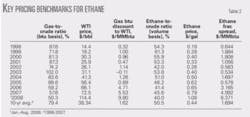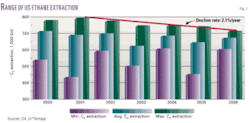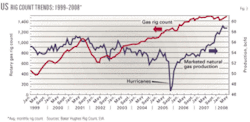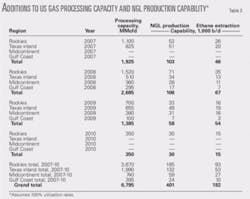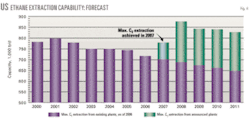Over the past 2 years, En*Vantage has been warning US gas processors that the rapid expansion of processing capacity will create a surplus of ethane extraction capacity.
The main concern then and now is that US gas processors are incurring more economic risks by increasing their leverage to ethane, unless ethane demand increases. Yet, our analysis indicates that the US petrochemical industry is not planning to expand ethylene capacity.
Additionally, existing ethylene plants are limited in consuming or cracking substantially more ethane because adequate ethane pipeline capacity to a number of ethylene facilities is lacking, and some heavy-feedstock plants need to be retooled to crack more ethane.
The current economic recession has only exacerbated ethane oversupply and has actually caused the shakeout of some marginal US ethylene capacity. When the economy recovers, these structural changes in supply and demand for ethane will mute any substantial or prolonged recovery in ethane-extraction economics.
It will take a great deal of cooperation and planning between the US gas processing and petrochemical industries to see if ethane demand can be increased.
To describe ethane’s current and future market environment in more detail, this discussion is divided into two parts. The first part this week examines the fundamentals that drive US ethane balances, details market forces driving the expansion of US gas processing capacity, and forecasts how these expansions will increase the capability of the US processing industry to extract ethane.
The conclusion (OGJ, Feb. 23, 2009) examines the changes occurring in the US ethylene industry, its capability to absorb additional ethane supplies, and how this will affect ethane balances and the relative value of ethane in the future. That article will provide the strategic implications of ethane’s future for gas producers, gas processors, downstream midstream players, and petrochemical companies.
Background
Ethane can be the most important NGL for US gas processors and for those midstream companies that transport, store, and fractionate NGLs. It constitutes about 40% of the average NGL barrel extracted from natural gas in the US. Ethane is the most economically sensitive NGL, however, and its supply and demand can substantially swing with changes in the economy
Despite ethane’s inherent volatility, many gas processors and midstream companies have recently been making a significant bet on ethane’s future viability. Over the past several years, companies have committed considerable investment to recover, transport, and fractionate NGLs with ethane contents of at least 40%. And these projects have been coming online and will continue to do so through 2010.
By the end of the construction boom, total US gas processing capacity will have been expanded by 11%, or 6.8 bcfd, over 2006 levels to process new gas plays in Texas, Oklahoma, and the Rockies. All of this new processing capacity is cryogenic with deep ethane extraction capability.
Less than a year ago, the huge bet on more cryogenic processing capacity and downstream NGL infrastructure seemed smart. From 2006 through August of 2008, ethane prices and frac spreads (the market value of ethane less the market value of natural gas) were climbing and reached record highs the past summer.
US gas processing had never been so profitable, ethane extraction was being maximized, and the cyclicality inherent in this business seemed remote. Many industry participants took for granted that the good times would last for ethane and that the US petrochemical industry, the only major market for ethane, would always have a growing appetite for the NGL.
True to its cyclical nature, ethane fundamentals cratered in a matter of a few weeks in late 2008. The economic recession and resulting collapse in crude oil prices has gas processors facing historically low ethane margins. Many in the industry are comparing the current environment for ethane extraction with 2003 when gas processors experienced dismal ethane extraction economics. There are expectations that these economics will bounce back when the economy recovers and crude prices resume their upward climb, just as they did 5 years ago.
Gas processors and midstream companies operating NGL assets should not, however, get their hopes too high. This business being cyclical does not mean that processing margins for ethane extraction will follow the same road back to the record high levels experienced in 2007-08.
Ethane: supply, demand, pricing
US ethane balances can appear simple, but complex forces drive the supply, demand, and pricing of ethane. Over a 5-year period 2003-07, the US market for ethane averaged around 750,000 b/d (Table 1).
Almost 90% of US ethane supplies comes from the processing of natural gas. Gas processors have considerable discretion to recover ethane or leave it in the gas stream depending on the economic incentive to extract ethane.
The refining industry also produces an ethane-ethylene stream as a by-product of processing crude oil into refined products. The equivalent amount of ethane from this stream represents the remaining ethane supplied to the market. Because it is a by-product of refinery operations, equivalent ethane supplies from crude oil refining remain fairly stable.
It is important to note that US ethane supplies come only from US gas processors and refiners and that ethane is a self-contained market in the US. Overland imports or exports of ethane are nonexistent because there are no NGL pipelines capable of transporting ethane into or out of the country. Further, waterborne imports or exports of ethane on a standalone basis are also nonexistent due to the cost of shipping ethane in liquefied form.
Rich or “hot” LNG (LNG with high heat content), however, will have ethane entrained but requires an extraction facility at a LNG receiving terminal to separate ethane from the LNG stream. There is only one US LNG receiving terminal that will have that capability to extract ethane from hot LNG, discussed later.
As previously stated, the production of ethylene represents the only major end-use for US ethane. (Very minor end uses for ethane include blending into propane for fuel uses and directly as a fuel.) The feedstock flexibility of the US ethylene industry forces ethane to compete with other NGLs and petroleum-derived feedstocks from crude oil refining, mainly naphtha and gas oil.
Since crude oil prices are a major determinant of the price of the ethylene feedstocks that compete with ethane, it stands to reason that there is a relationship between ethane’s market value and the price of crude oil. The btu value of ethane or its cost basis is determined by the market value of natural gas where the natural gas is produced.
The discretionary nature of ethane extraction from gas processing and the flexibility of the US ethylene industry to crack ethane makes the range for ethane demand quite wide. Within the most recent 5-year timeframe, it has swung as low as 475,000 b/d and as high as 850,000 b/d around the average of 750,000 b/d. The volatility in ethane supply and demand can be due to complex factors.
Supply of ethane from gas processing can be influenced by:
- Ethane frac spreads.
- Gas processing contracts.
- Type of processing plant.
- Plant location.
- Gas quantity and quality.
The following factors can influence the demand for ethane as an ethylene feedstock:
- Ethylene business cycles.
- Ethylene plant (steam cracker) capacities and feedstock capabilities.
- Competing ethylene feedstocks.
- Ethylene coproducts.
- Ethylene derivative imports/exports.
Benchmarks
To simplify the analysis of these complex factors that drive the supply and demand of ethane, En*Vantage focused on a few benchmarks as described below. Note that these benchmarks must be analyzed simultaneously to obtain the most complete picture of what is happening to ethane supply, demand, and prices.
· Natural gas to crude price ratio (Henry Hub gas price to WTI price on a thermal basis). Because ethane’s floor value is set by natural gas and its market value is largely determined by crude prices, the gas-to-crude price ratio is a good directional, inverse benchmark for ethane’s frac spread and the economic attractiveness of ethane as an ethylene feedstock.
The lower the gas-to-crude price ratio, the better the environment for ethane’s frac spreads and its attractiveness as an ethylene feedstock.
· Absolute value of WTI. Rising crude prices typically imply higher prices for ethane, assuming ethane’s value to crude has not deteriorated, and rising crude prices result in wider ethane frac spreads, assuming gas-to-crude ratios remain fairly stable.
· Ethane to crude price ratio (Mt. Belvieu ethane price to WTI price, $/bbl). Ethane’s price relationship to crude is a good measure in determining how well ethane fundamentals are doing. When ethane balances are tight, ethane typically sells at a relationship to crude that is higher than its historical average of 50%.
· Ethane frac spread (Mt. Belvieu ethane price less Henry Hub gas price). Ethane’s frac spread measures the economic incentive to extract ethane for gas producers and those processors with “keep-whole” processing contracts (replacing plant fuel and shrinkage).
· Natural gas production and gas quality. If gas production is rising and is of sufficient quality to process and recover ethane, then it is highly probable that new processing capacity will be added and that existing capacity will probably extract more NGLs.
· US ethylene production and industry configuration. The types of US ethylene plants operating and the amount ethylene produced to meet demand greatly influence the amount of ethane cracked or consumed as a feedstock.
Ethane 2006-08
An examination of the key pricing drivers for ethane 2006-08 illustrates the extraordinary period for ethane prices and frac spreads compared to previous years and the 10-year average (Table 2).
In a 32-month period from 2006 to August of 2008, conditions were perfect for gas processors to maximize ethane profitability whether processors had keep-whole or percent of liquid proceeds (POP) contracts. Low gas-to-crude price ratios, high crude prices, and reasonable ethane values relative to crude, all combined to make the perfect recipe for extremely attractive ethane frac spreads for those processors with keep-whole contracts and record high ethane prices for those processors with POP contracts.
The ethane frac spreads achieved during this period are so remarkable because the long-term average for the spread is only $1.69/MMbtu. More sobering is the fact that since 1991 ethane frac spreads have traded 66% of the time below $1.50/MMbtu, and 33% of the time below $0.75/MMbtu. Based on history alone, odds were that ethane frac spreads could not sustain these lofty levels.
Also, two very important points to consider during this 32-month period:
New plants, supplies
At the end of 2006, LPG Almanac reported about 490 gas processing plants operating in the US with an inlet-gas capacity of about 64 bcfd. During that year, 43 bcfd, or 81%, of US marketable natural gas production was processed, an operating rate of 66%.
This may seem an unusually low utilization rate compared with the relatively higher operating rates typically seen in refining and petrochemical operations. But it is quite normal for US gas processing to operate at utilization rates of less than 70% because processing plants generally outlive the local or regional gas production that originally fed the plants due to production declines. This is particularly the case for Gulf Coast processing plants where Gulf of Mexico gas production has been in decline.
From 2001 to the end of 2006, EIA reported US marketable gas production was declining at a little more than 1%/year. During this period En*Vantage analyzed EIA monthly natural gas plant field production data for each processing region to determine the effects of declining natural gas production on NGL extraction volumes, in particular ethane.
Our analysis revealed that during any given year, ethane extraction can swing over a wide range. These swings can be driven by such factors as extraction economics, variations in gas production, plant maintenance, NGL take-away problems, and weather events. Examining only annual average extraction volumes makes it difficult to determine underlying trends over time because of the amount of “noise” that can be imbedded in the averages.
To determine ethane extraction trends, En*Vantage tabulated the maximum amount of ethane recovered in each processing region within a given year. The regional maximum extraction levels should better reflect the actual capability to extract ethane within that region when operating and economic conditions are more favorable. Totaling the regional maximum volumes gives an indication of the US processing industry’s capability to extract ethane in that particular year.
Before the current boom in gas plant construction started in 2007, US ethane extraction was declining at 2.1%/year, as measured by the maximum ethane volumes extracted by gas processors 2001-06 (Fig. 1). As a side note, a similar analysis of total NGL extraction shows a decline of 2.4%/year during this period. Our analysis revealed the decline in NGL extraction, including ethane, was caused by natural gas production declines and to some extent leaner natural gas.
While ethane extraction was declining along with natural gas production, innovative drilling and stimulation technologies were sparking interest in new and emerging gas plays, both conventional and unconventional, in the Texas, Midcontinent, and Rocky Mountain producing regions. Consequently there was a renaissance in proved natural gas reserves in these regions compared with mature areas along the Gulf Coast and offshore Gulf of Mexico (Fig. 2). Much of these new gas reserves additions have relatively high liquid content, ranging between 2 and 5 gal/Mcf (GPM).
It is no surprise that, as gas drilling picked up in 2007 with the upward climb in crude oil and natural gas prices, US natural gas production began to increase dramatically and is up 11% since 2006 (Fig. 3).
In anticipation of the need to serve rising gas production, gas processors began aggressively to announce new processing plants (Table 3). All of these new plants are cryogenic to maximize ethane recoveries, and many producers insisted that gas processors build cryogenic plants to capture the huge economic uplift that ethane offered.
A survey of each new announcement by En*Vantage revealed that in 2007, a little more than 1.9 bcfd of gas processing capacity was completed. In 2008, about 2.7 bcfd of additional processing capacity was to be operational; another 1.8 bcfd in 2009; and another 350 MMcfd in 2010.
In total, 6.8 bcfd of gas processing capacity should be added in 2007-10, with 54% of this capacity in the Rockies, 29% in Texas inland basins, 11% in Midcontinent mainly in Oklahoma, and 6% along the Gulf Coast. En*Vantage estimates that this new capacity, if it were to operate full out, would be able to extract 401,000 b/d of NGL mix, of which 182,000 b/d would be ethane.
Of course, it is not realistic to expect these new processing plants will be operating at 100% of capacity when they are completed. To estimate a more realistic operating schedule for these plants, En*Vantage made the following assumptions:
- 50% load factor during the first quarter of operation.
- 65% load factor in second quarter.
- 75% load factor in third quarter.
- 80% load factor in fourth quarter.
- After 1 full year at 80% load factor, plant inlet volumes would decline at 2%/year.
We also estimated NGL recoveries for each new announced plant based on the estimated gas quality in the producing basin feeding the plant. For each new plant, ethane was assumed to constitute 40% of the NGL stream recovered except in cases where En*Vantage had information that ethane recoveries would be higher for a particular plant. For any plant built before 2007, we assumed a maximum ability to extract ethane would continue to decline at 2%/year.
Adding our estimated ethane extraction from new plants to the ethane extracted from existing plants shows that US processing will be able to extract more than 800,000 b/d for the next several years (Fig. 4). Actual data for 2007 showed that US processing hit a maximum ethane extraction level of 778,000 b/d, and it appears that in 2008, that level reached 810,000 b/d before Hurricanes Gustav and Ike hit the Louisiana and Texas Gulf Coasts, respectively.
In addition to the new gas processing plants that are coming online, Trunkline LNG is installing infrastructure at its Lake Charles LNG terminal to allow for ambient-air vaporization of LNG and extraction of NGLs from the LNG. The extraction plant will be able to process 1.050 bcfd of LNG and be in service in second-quarter 2009. The NGLs that are entrained in LNG are mostly ethane with some propane and butanes.
Depending on the heat content of the LNG being imported, 18,000-48,000 b/d of ethane could be extracted. En*Vantage estimates that the Trunkline LNG terminal could process LNG with an average heat content of 1,150 (±25)/std. cu ft. That would imply an NGL recovery rate of at least 39,000 b/d, with ethane extraction about 24,000 b/d.
One note of caution regarding Trunkline’s Lake Charles LNG terminal: There is no certainty that NGLs will be extracted daily. Extraction will depend on the need to import LNG, the amount and quality of the LNG being brought to the terminal, and whether there is an economic justification to extract the ethane. If ethane frac spreads are any where near levels seen in 2007 or first-half 2008, it is very likely ethane extraction will occur. And, because the volume of ethane extracted at the Trunkline LNG processing plant can be quite large, it can have an immediate capping effect on ethane frac spreads and cause havoc to ethane balances on the Gulf Coast.
Even without ethane extraction at Trunkline, US gas processing is on a path of overbuilding ethane extraction capability. Unless projects that have been announced for 2009 are delayed or canceled by the current economic recession, En*Vantage expects industry will be able to extract 800,000-850,000 b/d of ethane. The Trunkline terminal will only add to this capability, if and when it starts extracting ethane from LNG.
The key questions are whether the US ethylene industry can absorb this additional ethane and how will this impact ethane balances and the relative value of ethane. The concluding article in this series analyzes these concerns and implications for gas producers, gas processors, and ethylene producers.
The author
Peter Fasullo ([email protected]) is cofounder and principal of En*Vantage Inc., Houston, an energy investment and advisory firm. He began his career with MW Kellogg in 1976 as a process engineer and went on to Pace Consultants & Engineers in the early 1980s as a market analysis consultant. Following Pace, he spent 14 years with Valero Energy Corp. In 1996, Fasullo became head of Valero’s corporate development department and in 1997 became head of MAPCO’s corporate and business development department. Fasullo holds a masters of chemical engineering from Rice University and an MBA from the University of Houston.

